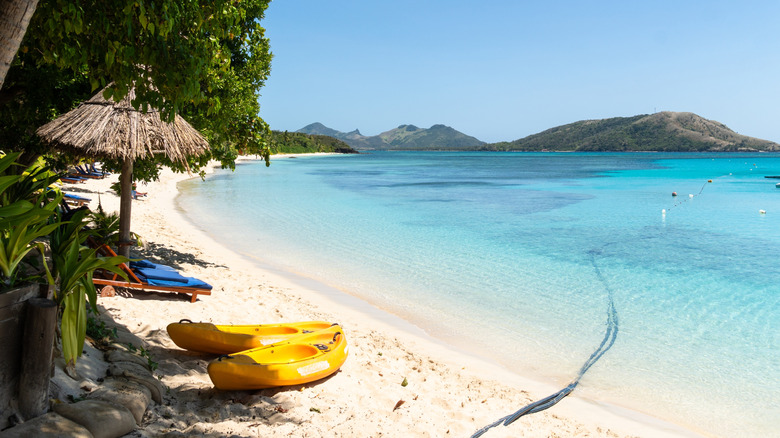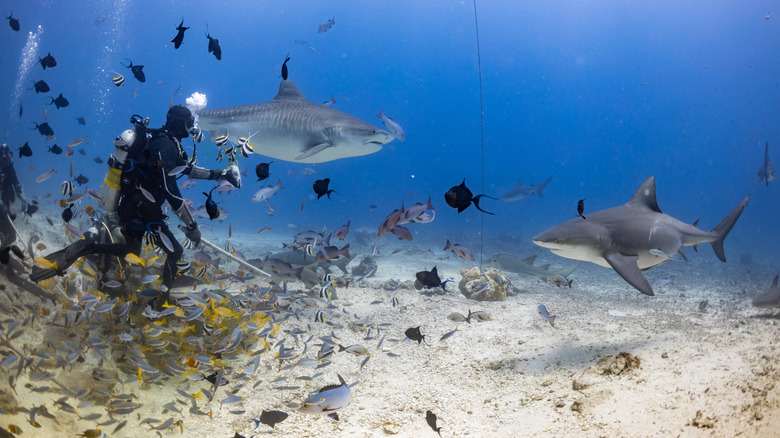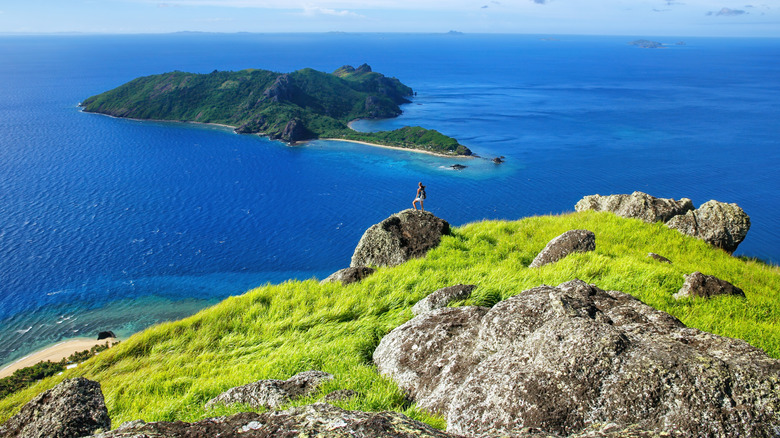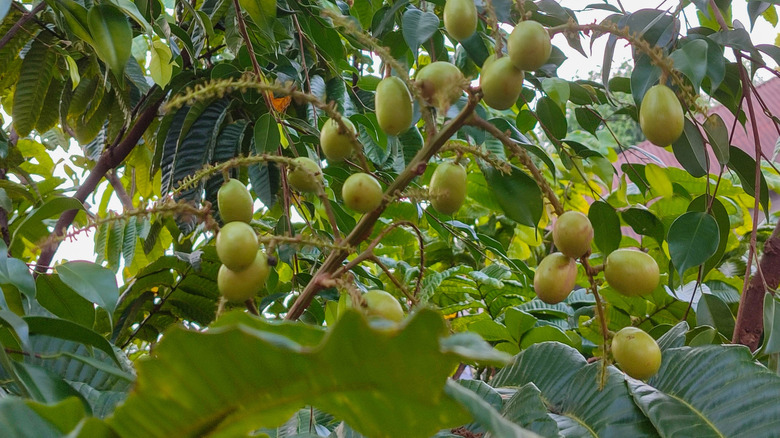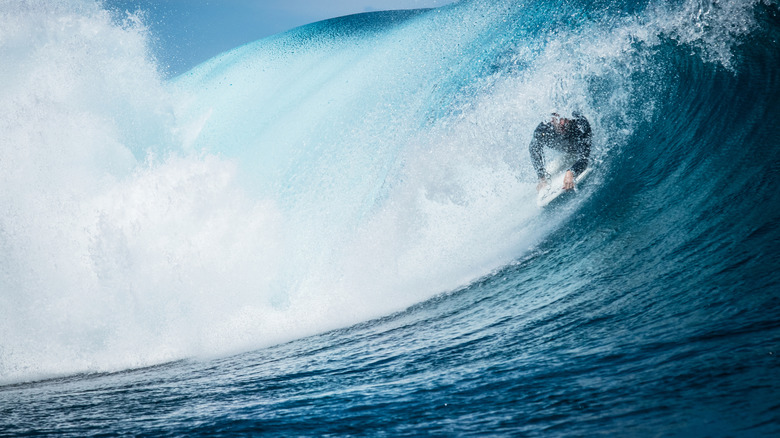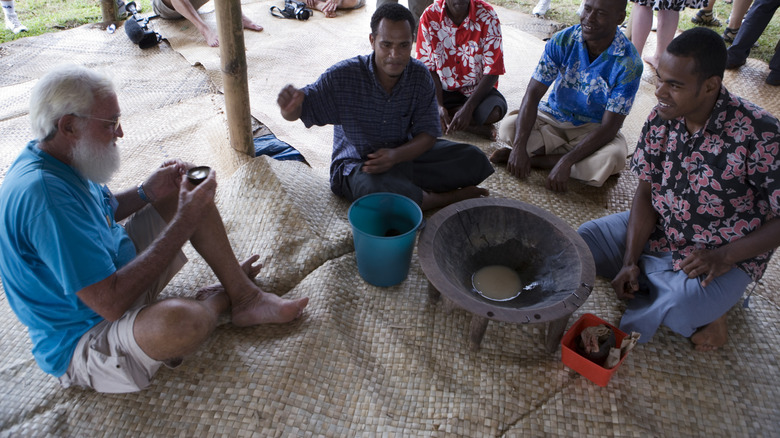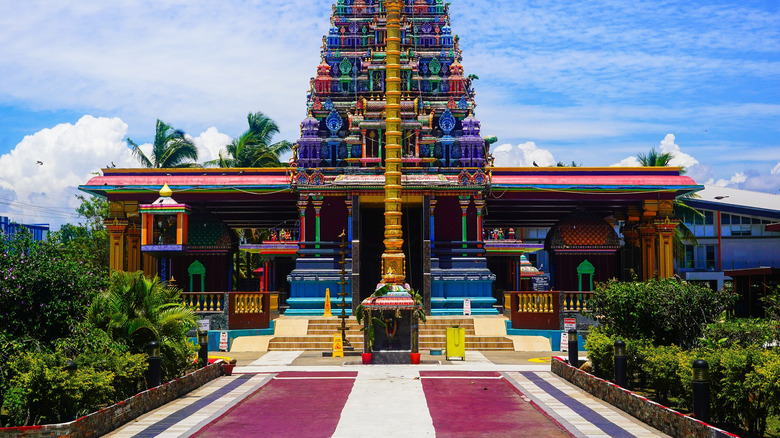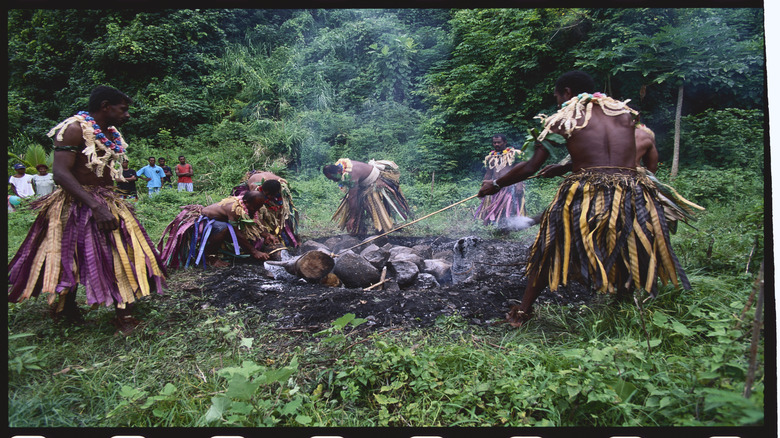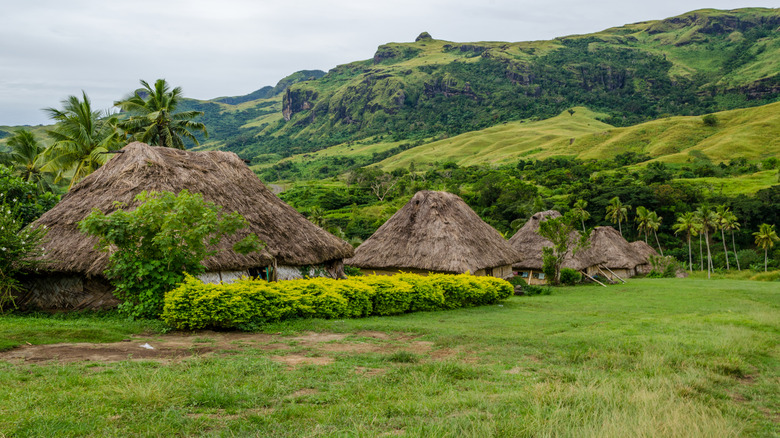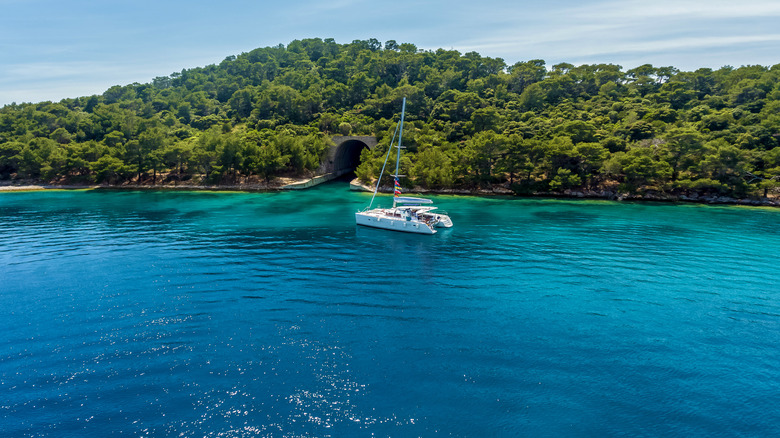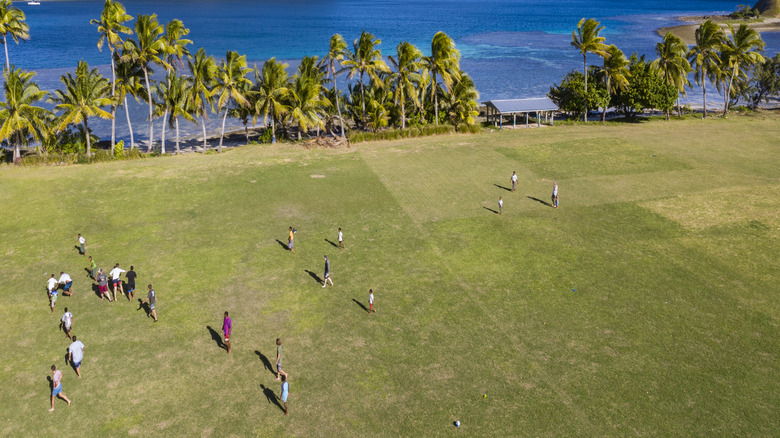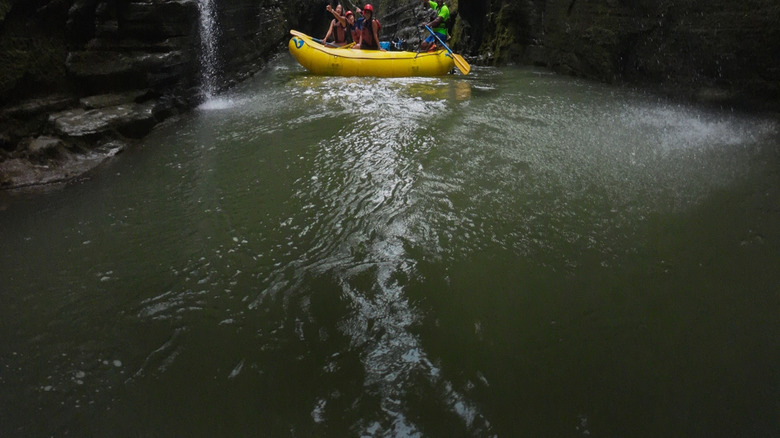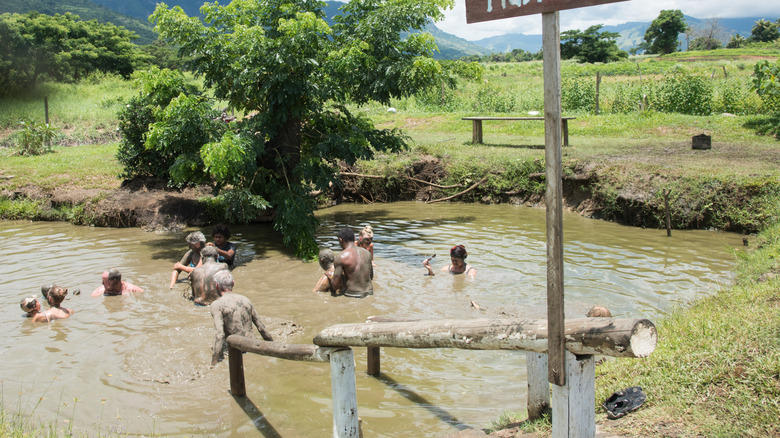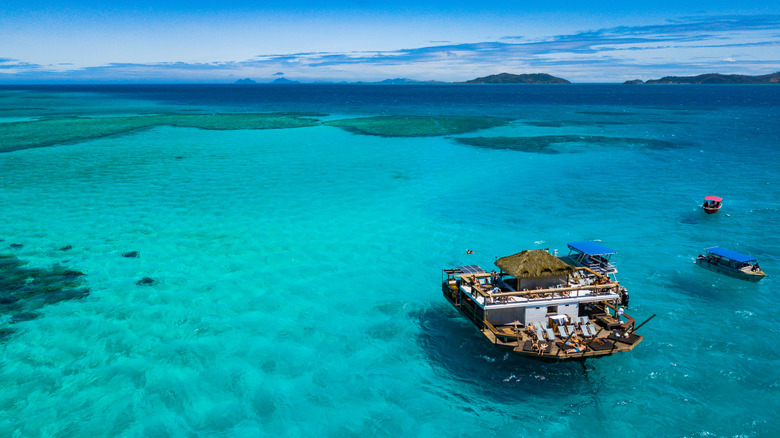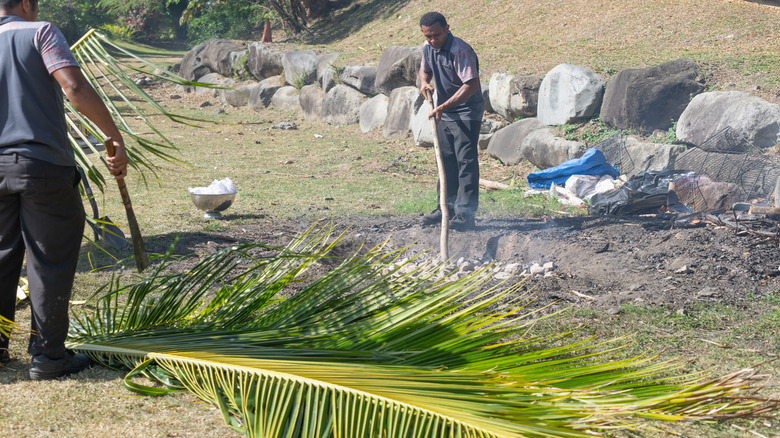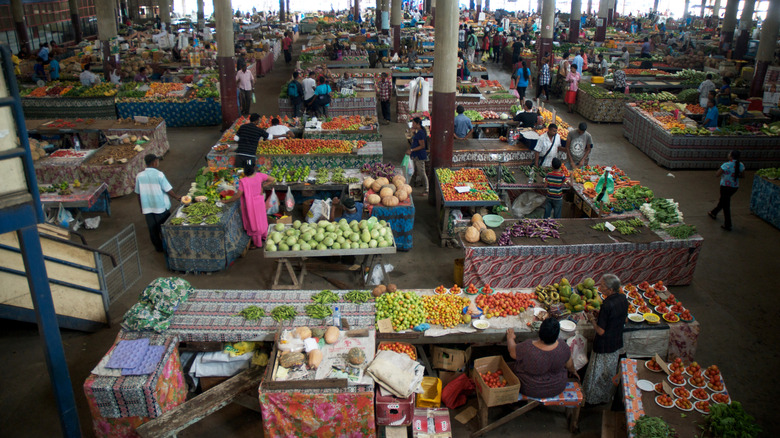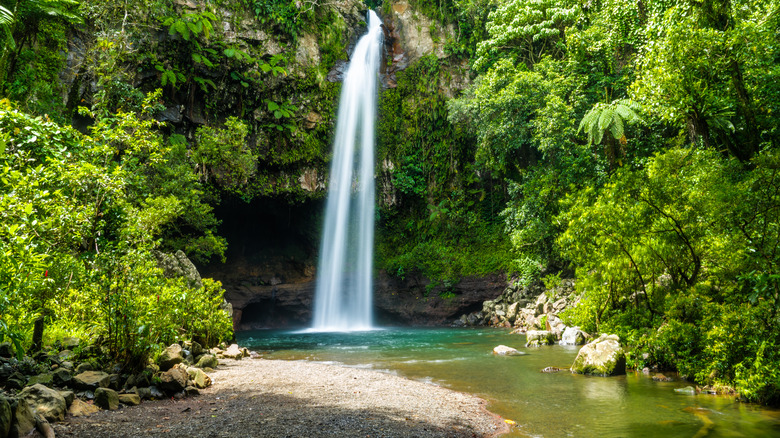The Most Incredible Things To Do In Fiji During Your Island Vacation, According To Travelers
A nation of hundreds of islands in the South Pacific, Fiji is paradise come to life (here's a primer to read before your vacation to Fiji). This is a remote destination, more than 1,000 miles from New Zealand. With a fascinating history and a mix of cultural influences, Fiji promises travelers a rich variety, with islands to fit any travel style. That's not just in its terrain, which ranges from jagged peaks to soft-sand beaches, but also within the cuisine and religion.
The nation has many points of interest, from top-rated islands to cities filled with shops and countless diversions beyond. The choices of what to do in Fiji are nigh endless, and can be a little overwhelming. To help you focus on the highlights, we've narrowed down the list. Looking at the official Fiji tourism site, blogs like Destinationless Travel, and pulling on memories from our own travels to the islands, we have come up with the most incredible things to do in Fiji.
Snorkel and dive
Fiji is a hotspot for marine life. Part of that is thanks to its location, moored in the center of the Pacific Ocean bordering the Coral Triangle, far from large hubs of population. The warm water year-round ensures ideal conditions for coral, and these healthy reefs attract large numbers of fish. What this all means, for visitors, is that they will be able to see a vast variety of sea creatures, whatever time of year they visit. Taveuni, commonly known as the Garden Island, is where to find Rainbow Reef.
The esteemed marine conservationist Jacques Cousteau labeled this reef "the soft coral capital of the world," high praise indeed. Malolo Lailai offers travelers the chance to swim among turtles, rays, and sharks in the Mamanuca chain of islands. For avid shark enthusiasts, nothing beats a dive in Beqa Lagoon, not far from the main island of Viti Levu. There are more than five varieties of sharks, including bull sharks and tiger sharks.
Take a hike
If it is a choice of treks that you are after, then starting with Fiji's 12 best walks and hiking trails is a good launching point. Across the many islands of Fiji, there are many fantastic hikes, ranging from easy to challenging. These manage to take in the enviable breadth of Fiji's various environments. Some rumble along plains, showcasing the country's grand open spaces. Others wind along the coast and allow visitors to appreciate the scenic beauty of Fiji's shores.
There are also hikes that climb steep hills and mountains, and remind visitors that Fiji isn't a destination that is all about sea and sand. A number of incredible hikes are worth seeking out. In Sigatoka Sand Dunes National Heritage Walk, the walk features trails through forest and sections out on towering sand dunes. In Taveuni, the Lavena Coastal Walk includes villages and pretty beaches, and even a picturesque waterfall.
Savor the local fruit
Spend some time in Fiji, and it will become evident that agriculture is steadfastly linked to daily life. Working the land is a key component of the country's economy, with one-quarter of Fiji's residents reliant on agriculture for their livelihood. In areas outside the larger cities, more than four-fifths of Fijians work in the field (no pun intended). Visitors are among those who benefit from the rich vein of products that Fijians can cultivate. For fruit lovers, the country is blessed with a great variety of tropical delights, some of which might come as discoveries to visitors.
Rambutan looks like hairy alien pods, but their furry exterior hides a smooth, succulent fruit within. While passion fruits are often associated with a sharp taste, the purple-skinned ones available across Fiji mix sweet and tart flavor profiles. Custard apples have a green exterior, and sections of creamy pulp surround large black seeds inside. Other goodies include mangos, papayas, breadfruit, dragon fruit, and pomelos.
Ride a wave
Given that Fiji is a nation of islands, water is never hard to find. Some locations around the islands are primed for surfers, breaks, and waves that will thrill anyone who mounts a board. Surf rats generally head to three destinations in the country. The Coral Coast refers to a stretch of the southern part of Viti Levu, Fiji's main island.
Surf rolls in from the southeast and southwest, depending on the time of year, and summers here are a good choice for surfers due to the consistent swells. Popular spots for board riders include the mouth of the Sigatoka River, Hideaways, and Frigates Pass. The Mamanucas archipelago sits west of Viti Levu, and it is a great destination for surfing spots like Cloudbreak and Restaurants throughout the year. That said, visitors should note the best and worst times to visit the country. Taveuni Island is good for surfing from November to April, with waves rolling in from the south and north.
Join a kava ceremony
Kava is a root that is part of the pepper family, but more than simply being a plant, it is indelibly tied to a beloved tradition in Fijian society. The root is ground and mixed with water to make a bitter, tea-like drink which, while not alcoholic, does have similar effects to booze. Drink kava, and you might start to feel a little light-headed, relaxed, smiley, and generally at ease. At villages all around Fiji, locals huddle around a large mixing bowl to drink kava, a ceremony that is a way to bring everyone together.
Villagers also perform the ceremony to welcome outsiders to their corner of the Earth. During a ceremony, participants all drink from the same bowl and cup, and they usually down the drink in one go. The words "bula" (hello) and "maca" (a word to signify that the drink is finished) are used before and after each drink, and clapping is an intrinsic part of the ceremony. This is a wonderful piece of Fijian culture — we know from experience. If you can't get to a village, fret not; many hotels hold their own kava ceremony on-site.
See Indian temples
Even though Fiji is thousands of miles southeast of India, the South Pacific country has a huge Indian-descendant population. Known as Indo-Fijians, they make up more than one-third of Fiji's total population. They can trace their origins to the late 1800s, when Indians were brought over to work the sugar-cane fields as indentured labor. Many settled in the country, started families, and their numbers grew while their traditions endured.
One example of their continued presence and influence is the wealth of Indian temples on the islands. These are found primarily on Viti Levu and Vanua Levu, the two islands where most Indo-Fijians live today; more than 50 temples are spread across these two islands. Perhaps the most impressive of them all is the Sri Siva Subramaniya Swami Temple, located in Nadi. The beautiful, colorful entry tower, or "gopura," is filled with intricate carvings that depict important characters from mythology and lore.
Watch fire walkers
On the island of Beqa, south of Viti Levu, sane men actually walk on searing rocks unscathed. This is a feat that dates back about five centuries, started in a remote village on the island called Nakarovu. According to local mythology, a man sought out an eel to give as a gift to one of the elders, but mistakenly captured a spirit. To gain freedom, the spirit bestowed dominion over fire on the young man and his progeny.
Ever since, people from the island's Sawau tribe, descended from that young man, have been able to step on the heated river stones used in the fire-walking ceremony. The stones are placed in a large pit and heated by a wood fire, and following a blessing by a priest, the men walk over them. For visitors who can't see the spectacle in Beqa, the ceremony is sometimes staged by members of that tribe in hotels near Beqa.
Visit a village
Like the kava ceremony, visiting a village is another way to really get under the skin of Fijian culture. But first, we must make one thing clear. By visiting a village, we don't mean spending time at the Fiji Culture Village. That destination, close to the international airport at Nadi, is a commercial tourist draw, one where travelers get to see staged mat weaving, dance performances, and singing. Sure, you'll see Fijians doing Fijian things, but it is all a bit contrived and neatly packaged.
To really appreciate the wondrous simplicity and authentic joy of life in Fiji, visit an actual village. Travelers can arrange this through a tour operator or perhaps through their hotel. They might also get to know a Fijian during their trip, a local who invites them to see their home village. In the village, you will hopefully get to join a kava ceremony, be welcomed by a village elder, and maybe even partake in a meal. Best of all, you will get to see what makes Fijian villages such special places.
Hop on a cruise
While the interiors of Fiji are a sight to melt to heart, the sea is what draws many tourists to the islands. Travelers can certainly enjoy the water with a swim, snorkel, or dive, but to get an overview of the expanses of water and their grand beauty, nothing quite beats a day cruise. Several cruise operators have daily departures from Port Denarau, close to Nadi and the resorts of Denarau Island. Trips usually take place aboard yachts or catamarans and offer a variety of experiences.
Some make their way to small, secluded islands with minimal facilities but promise sultry beaches and clear seas. On other trips, the journey is the real appeal, a way to take in the bountiful sea, and leap into the gorgeous blue depths along the way. Some excursions bring passengers to locations teeming with birds, turtles, or expansive coral reefs.
Watch a game of rugby
While Americans adore baseball, Indians live and breathe cricket, and the Brazilians have soccer. In Fiji, the sport that most closely resembles a quasi-religion is rugby. A rapid, physically demanding game where players can only pass the oval-shaped ball backwards or sideways, rugby is played all over the islands with an unquenchable passion. The love of the sport and the esteem in which it is held have led to global success for the national squad. The men's sevens teams won two Olympic golds in the past decade, while the nation made it to the last eight for the first time at the 2023 Rugby World Cup.
Fijian rugby is known for its rapid, relentless attack, and players with excellent ball handling skills, so watching a game in the country is truly thrilling. Even if you can't see a national game, or one of the high-profile domestic match-ups, often held at the HFC Bank Stadium in Suva, try to catch a regional or local match. The raucous cheering and endlessly upbeat atmosphere will be unforgettable.
Enjoy some amazing beaches
Where to start with this one? While we like to use the phrase "you'll be spoiled for choice" when it comes to beaches in Fiji, that really is an accurate description. The beaches in Fiji are sublime, and there are so many of them that these 10 beautiful beaches in the country only really scratch the surface of what is out there. That isn't wholly surprising since Fiji is a nation of hundreds of islands, after all.
Many Fijian coastlines promise the archetypal image of a heavenly beach — soft, white sand, crystal-clear turquoise water, skinny palm trees whose leaves gently rustle in the coastal breeze. One beach that consistently receives plaudits —the Travel Channel called it the best beach in the country — is Natadola Beach. Located on the main island of Viti Levu, it presents the perfect combination of a gently curving coastline bookended by forested headlands, sugary sand, and inviting blue seas.
Go tubing or rafting
While travelers might automatically think of the sea when it comes to aquatic adventure, the reality is that Fiji is also home to many lively waterways. River Tubing Fiji takes guests on leisurely, relaxing trips along the Navua River, in Viti Levu's southern half. Based in the Namosi Highlands, the organization offers trips to individuals and groups, and sometimes up to 20 tubers will be holding hands as they float down the river or push through gentle rapids.
For tourists who like their water excitement a little more high-octane, a white-water rafting trip might be a better option. Oars has excursions along the Upper Navua Gorge, paddling through Class II and Class III rapids. The cascades and swirling eddies of water start pretty soon after participants push off into the river. And while the water might provide the thrills and possibly spills, the scenery is equally memorable. Travelers can expect to wind through slender canyons of lava rock, where ferns and vines add greenery, and where a parade of waterfalls supplies a visually and rhythmically hypnotic diversion.
Slip into a mud pool
While not all muds are created equal, mud baths have been shown to have therapeutic effects. Thanks to the minerals contained in the mud — magnesium, bromine, zinc, and more — users of mud baths can look forward to healthier skin with fewer toxins, rejuvenating exfoliation, and even relaxed muscles. The process is fairly simple, with visitors slathering themselves in the soupy mud, letting it dry, and then scrubbing it off.
In Fiji, close to Nadi, there are a couple of places next to each other where travelers can enjoy a mud bath. This is a fun excursion, whether you visit Sabeto Hotspring Mudpool or the neighboring Tifajek Mud Pool and Hot Spring. It begins when you slide into the mud pool, cover yourself from head to toe in the dark goop, take the obligatory humorous photos, and then lie in the sun. Other parts of the equation include cleaning up, a soak in a hot spring, and a traditional massage. Don't expect anything fancy, these mud pools are simple operations, but the whole messy experience is a blast.
Hit a floating bar
What's cooler than having a drink at a bar that is out on the sea? Going to two bars at sea, which visitors to Fiji can do. In addition to the novelty of such a set-up, these bars are also fantastic subjects for Insta-worthy shots. Cloud 9 is in the Mamanuca archipelago, a few miles from Malolo Island. It looks like a cross between a giant floating raft and a beach club. Awnings cover sections of it, allowing visitors to be shaded from the sun, while lounge chairs and daybeds allow them to fully take advantage of the relaxed setting.
Cloud 9 expands over two levels and features a full bar with drinks from all over the globe, and a pizzeria where the oven is wood-fired. Music spun by on-site DJs adds an easy vibe to the proceedings. In the same general area, but to the east, Seventh Heaven Fiji has a similar set-up. Like Cloud 9, solar panels at Seventh Heaven provide the power, while drinks, pizzas, and the chance to leap into the warm blue sea supply the fun.
Try the variety of food
Eating in Fiji promises a feast for the palate and the eyes. Thanks to the richness of the soil and the seas, and the cultural variety in the country, dishes explore a range of tastes and textures. For starters, visitors should try a traditional lovo. Lovo entails creating a pit in the ground, heating river rocks in it, then cooking the food in the pit, which is covered with banana leaves, sand, and soil so that it retains heat. Typical ingredients that are slow-cooked for an hour or two include meats, fish, yams, sweet potatoes, taro, pumpkins, and eggplants. This way of cooking imparts the food a smoky flavor and makes it meltingly tender.
Hotels might have a lovo night, so look out for one where you are staying. Another local specialty is kokoda, the national dish of Fiji, which is similar to ceviche that originated in Peru. Kokoda unites raw fish with lime, salad, and coconut milk to make a fresh, zesty, smooth delight. Of course, no trip to Fiji would be complete without sampling some of the fabulous Indian food. If it's choice you are after, then head to Suva, where the west of the city, around Victoria Parade, is home to more than 10 Indian restaurants within walking distance of one another.
Wander around a local market
One way to get an unfiltered window into the minutiae of everyday life in a destination is to visit a local market. That is where you can witness the interactions and rhythms between stall owners and shoppers, many of whom have built up an unspoken bond over many years. Local markets are like real-life improv theater, where unscripted actions and reactions occur throughout the day. Visitors have a few markets to choose from.
Suva's Municipal Market, in the heart of the city, is a hotbed of produce, including local fruits, and also crafts made by local artisans. These make great gifts for friends and family back home. Nadi has its own municipal market, where locals stock up on fruits and vegetables, while its handicraft market is the destination for fabrics, clothing, and tapa cloths. Lautoka Municipal Market is huge, a grid of vendors selling produce, meat, seafood, and even wooden carvings.
Methodology
To list everything there is to do in Fiji would require pages and pages of recommendations, which would be of little help to anyone. So we narrowed down our selection by looking at blogs like Destinationless Travel and Fiji's official tourism site. We also remembered our own time in Fiji, cherry-picking experiences that left a lasting impression. It was important to provide a variety of options, not just all adventure or all culture, so that travelers of all tastes could find something appealing among these picks.
